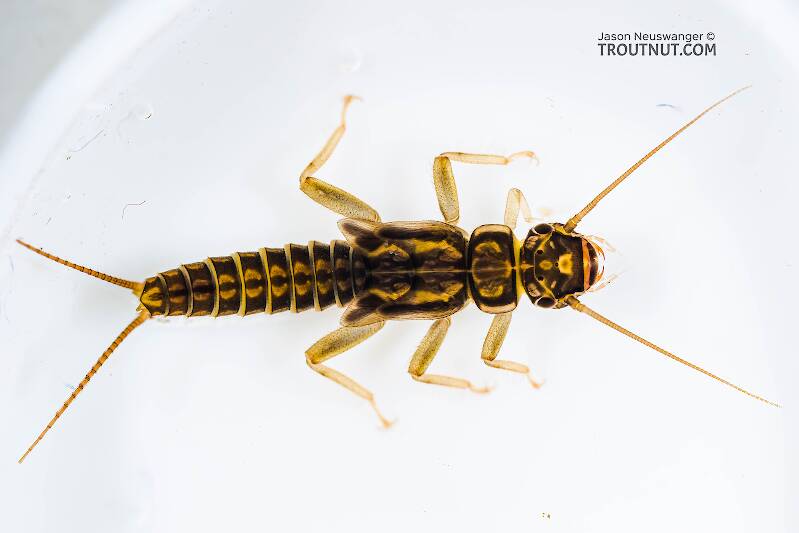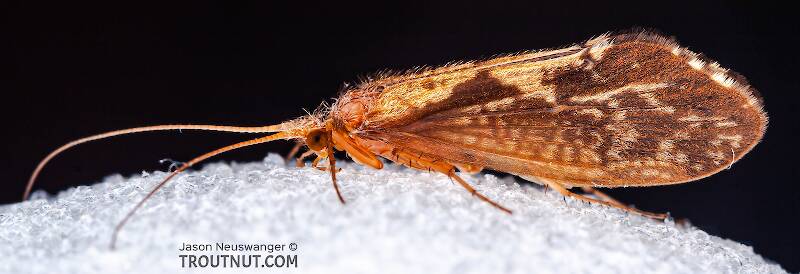
Blue-winged Olives
Baetis
Tiny Baetis mayflies are perhaps the most commonly encountered and imitated by anglers on all American trout streams due to their great abundance, widespread distribution, and trout-friendly emergence habits.
Featured on the forum


Troutnut is a project started in 2003 by salmonid ecologist Jason "Troutnut" Neuswanger to help anglers and
fly tyers unabashedly embrace the entomological side of the sport. Learn more about Troutnut or
support the project for an enhanced experience here.

This large caddisfly looks really neat close-up.
Vshivkova
Posts: 2
Posts: 2
Vshivkova on Nov 18, 2006November 18th, 2006, 11:56 am EST
It is not Limnephilidae, I guess it is some of Neophylax or other Thremmatinae. My reasons:a) color pattern look as in many Neophylax; at the base of hind leg spurs the only one black spine (in Limnephilidae - two sines; in Thremmatinae - 0 or one); 2) female genitalia is not as in Limnephilidae s.str.
Troutnut on Nov 18, 2006November 18th, 2006, 4:19 pm EST
Thanks. I'm going to move it to Neophylax for now as you've suggested. Glad to have experts weighing in!
Jason Neuswanger, Ph.D.
Troutnut and salmonid ecologist
Troutnut and salmonid ecologist
GONZO on Nov 19, 2006November 19th, 2006, 5:52 am EST
It's nice to have a more definitive opinion on this specimen. Obviously, some revisions have occurred at the family level. My latest references still list Uenoidae as the family of Neophylax. I'm curious to learn when the change to Thremmatinae happened. Does this revised family include any other important trout-stream genera? Are Eastern species like aniqua, concinnus, consimilis, fuscus, mitchelli, oliqius, and ornatus still all classified as Neophylax, or have the revisions influenced the genus level as well?
The Eastern Neophylax specie(s) I'm familiar with has a ragged "torn-paper" appearance to the rear of the top wing. The only references I have for this configuration are LaFontaine's description of N. rickeri, which he lists as a Western species, and website photos of N. ornatus (which, I believe, is not the species I see most often). Any thoughts, Vshivkova? DMM?
The Eastern Neophylax specie(s) I'm familiar with has a ragged "torn-paper" appearance to the rear of the top wing. The only references I have for this configuration are LaFontaine's description of N. rickeri, which he lists as a Western species, and website photos of N. ornatus (which, I believe, is not the species I see most often). Any thoughts, Vshivkova? DMM?
Taxon on Nov 19, 2006November 19th, 2006, 9:31 am EST
Gonzo-
All the species you mention remain Neophylax. This is most reliably verified on http://entweb.clemson.edu/database/trichopt/search.php.
All the species you mention remain Neophylax. This is most reliably verified on http://entweb.clemson.edu/database/trichopt/search.php.
GONZO on Nov 19, 2006November 19th, 2006, 10:14 am EST
Thanks Roger-
Apparently Thremmatinae is a subfamily under Uenoidae. Now, if someone can help identify my "torn-winged" Neophylax, I'll be all straightened out!
Apparently Thremmatinae is a subfamily under Uenoidae. Now, if someone can help identify my "torn-winged" Neophylax, I'll be all straightened out!
Taxon on Nov 19, 2006November 19th, 2006, 10:17 am EST
Gonzo-
Yes, that is correct. As best I can reconstruct, Neophylax was previously placed in the family Limnephilidae, subfamily Ueonoinae, but work published by Wiggins and Wisseman (in 1992) argued successfully for elevation of Ueoninae to family status.
Yes, that is correct. As best I can reconstruct, Neophylax was previously placed in the family Limnephilidae, subfamily Ueonoinae, but work published by Wiggins and Wisseman (in 1992) argued successfully for elevation of Ueoninae to family status.
Litobrancha on Nov 20, 2006November 20th, 2006, 6:56 am EST
good call. hadn't considered neophylax but the hind wing characters fit too.
neophylax concinnus has a distinctive dorsal color pattern that could be argued to to look like torn paper. it's kinda diamond shaped. this specimen looks sorta like the Neophylax ornatus specimen in the color plates in the new neophylax keys (vineyard wiggins schefter). but you can't tell by looking at just at that.
incidentally N ornatus comes out in the late spring or early summer (june-july) around here, the rest of the neophylax species are autumnal emergers (sept-october).
neophylax concinnus has a distinctive dorsal color pattern that could be argued to to look like torn paper. it's kinda diamond shaped. this specimen looks sorta like the Neophylax ornatus specimen in the color plates in the new neophylax keys (vineyard wiggins schefter). but you can't tell by looking at just at that.
incidentally N ornatus comes out in the late spring or early summer (june-july) around here, the rest of the neophylax species are autumnal emergers (sept-october).
GONZO on Nov 20, 2006November 20th, 2006, 7:49 am EST
Thanks Lito-
The info on the earlier emergence of ornatus confirms my assumption that it wasn't the species I'm used to seeing. I think that concinnus is a good possibility, though it's not recorded from many northeastern counties here in PA. It's also possible that what I recognize as a "torn-winged" Neophylax could be sister species with a similar appearance. They are fall emergers. The ones I've seen in the Poconos frequent fast, rocky little streams, while the only Neophylax I've noticed here in the Cumberland Valley came from a large valley limestoner (the Yellow Breeches). I've never inspected either very closely, so it's unlikely that I'll get any closer to identifying it/them until I capture some for comparison. No big deal--I've never encountered a fishable emergence of either. Until I do, it's just idle curiosity (from a fly-fishing perspective).
The info on the earlier emergence of ornatus confirms my assumption that it wasn't the species I'm used to seeing. I think that concinnus is a good possibility, though it's not recorded from many northeastern counties here in PA. It's also possible that what I recognize as a "torn-winged" Neophylax could be sister species with a similar appearance. They are fall emergers. The ones I've seen in the Poconos frequent fast, rocky little streams, while the only Neophylax I've noticed here in the Cumberland Valley came from a large valley limestoner (the Yellow Breeches). I've never inspected either very closely, so it's unlikely that I'll get any closer to identifying it/them until I capture some for comparison. No big deal--I've never encountered a fishable emergence of either. Until I do, it's just idle curiosity (from a fly-fishing perspective).
Quick Reply
Related Discussions
Topic
Replies
Last Reply
13
Jan 12, 2014
by PaulRoberts
by PaulRoberts
6
Apr 14, 2013
by Troutnut
by Troutnut




